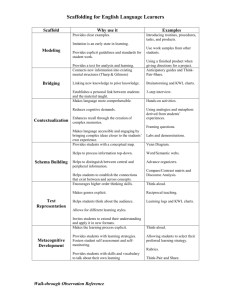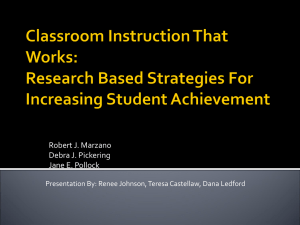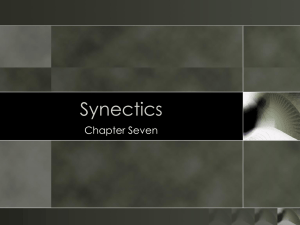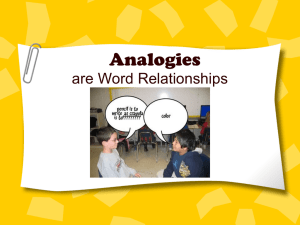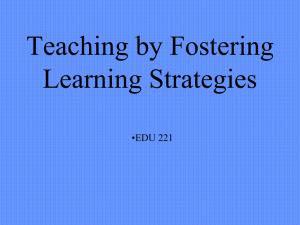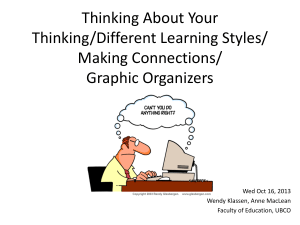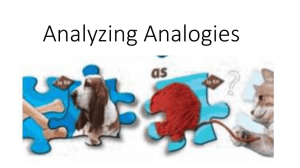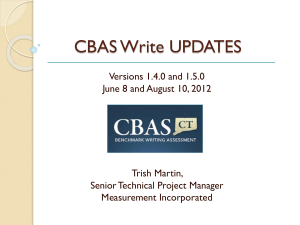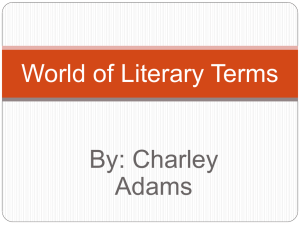Mod 4-D slides
advertisement
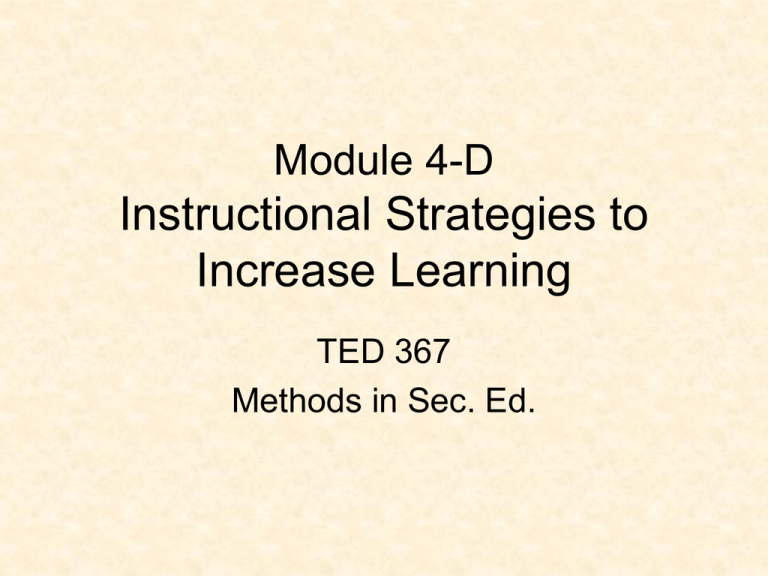
Module 4-D Instructional Strategies to Increase Learning TED 367 Methods in Sec. Ed. Reading • Read the following in the Duplass textbook: – Unit 5 (topics 21-25) Instructional Approaches – Unit 6 (topics 26-36) Methods Instructional Strategies to Increase Learning • Organizing Information into Concepts • Bridging Student Understanding • Visual Tools Introduction Fits info. into schema. Learning has taken place. New Stimulus Brain searches existing networks to find a place where new information fits. Irrelevant, not useful, unimportant, nonsensical data gets discarded. Introduction • Remember the Magical Number (Miller, 1956): Memory span of young adults was found to be 7 ± 2 elements (chunks) regardless of whether the elements were digits, letters, words, or other units. Introduction • Let’s look at some strategies to increase learning. Organizing Information into Concepts Chunking List, Group, Label Comparing and Contrasting Chunking • Chunking (also known as clustering) involves organizing information into larger units of information to aid in remembering and to support understanding (fit into existing neural networks). Chunking 9 individual planets • Mercury • Venus • Earth • Mars • Jupiter • Saturn • Uranus • Neptune • Pluto Groupings of planets • Terrestrial: – – – – Mercury Venus Earth Mars • Jovian: – – – – Jupiter Saturn Uranus Neptune • Ice: – Pluto 3 Parts of a PC (As Seen from Inside PC) Storage Devices Motherboard (Microprocessor, cards, RAM memory) Power Supply List, Group, and Label 1. Teacher asks the students as a group to come up with examples of something. Teacher lists these on the chalkboard. 2. Teacher asks the students if there are some ways to organize the items on the list into logical groups (either in dyads or as a group). • Teacher guides the class into understanding the structure of the concept by reorganizing the material in a table with labels. (Hilda Tabb, 1971) Comparing and Contrasting • Locate and record the similarities and differences between items. Bridging Student Understanding Analogies Mnemonic Devices Scaffolding Advance Organizers Analogies • All learning requires a bridge from an existing idea to a new idea. • These strategies provides a frame of reference, a link to prior knowledge (something familiar), and creates a context, a conceptualization for new learning. Existing Knowledge New Idea Analogies • “She is a real prima donna!” or “He is a real Don Juan!” or “You are a Brutus.” If these were said about someone, would the impressions you formed about the person stay with you longer than if an analogy had not been used? Analogies • Parallel construction • Analogies have: – Topic. – Characters. – A vehicle. – Vehicle characters. Analogy Construction Analogies Is like Analogies • If Earth were 24 hours old, dinosaurs would have existed about 1 hour ago, and humans began about 5 seconds ago. Analogies • If our solar system was shrunk to a length of 1 mile and located in Dallas, PA, how far would you have to travel before you reached the nearest star? Mnemonic Devices • Mnemonic devices help students remember information that has no connection to prior knowledge. Mnemonic Devices • My Very Educated Mother Just Served Us Nine Pizzas. • • • • • Huron Ontario Michigan Erie Superior • The country of Italy looks like a boot. Scaffolding • Scaffolding instruction moves students carefully from what they know to what they don’t know. Scaffolding Example 1. The teacher starts with something that is familiar and within the students’ capacity. • In English class: ask students who the good and bad guys were in the movie Gladiator. 2. The teacher relates this knowledge to new knowledge by using metaphors, examples, and demonstration. • Draw an analogy to characters in Macbeth. Scaffolding Example 3. The teacher marks critical features of the ideas presented by students and models the comparison process. 4. The teacher then shifts the burden for learning to the students. • Ask students to compare the characteristics and motives of characters from Gladiator and Macbeth, allowing students to direct the discussion. Advance Organizers 1. Advance Organizer – – Start the lesson by asking if the president of the United States is a “head of state,” what is a head of state, and so on and providing a definition along the way. The graphic organizer would be introduced to graphically depict some examples. Advance Organizers 2. Progressive Differentiation. The teacher examines and defines each of the cells in the graphic organizer so that they can be understood independently. 3. Integrative Reconciliation. The teacher examines the relationships between the cells. Visual Tools Thinking Process Maps Venn Diagrams Discipline-specific Organizers Advance Organizers Visual Learning Log Visual Tools • Benefits: – Helps students change their misconceptions. – Helps students organize and represent their thoughts. – Aids students to connect new knowledge to past experiences. – Helps students develop concepts (classify thoughts into smaller number of categories). Thinking Process Maps • General procedure: 1. Identify important concepts in material being studied [circle them]. 2. Rank the concepts from general to specific. 3. Arrange concepts on paper and connect related ideas with lines. Thinking Process Maps Primary Concept Venn Diagrams Items unique to A. Items common to both. Items unique to B. Discipline-specific Organizers • Biology: Life-cycle diagrams. • Math: Decision trees. • Reading: Text structures. Visual Learning Log • Students keep a graphic log of what they have learned. Using Music/Video Some Benefits of Music in the Classroom • Establish a positive learning atmosphere. • Build a sense of learner anticipation. • Energize learning activities. • Change learner brain wave state. • Help focus concentration. • Help increase attention. From Music and Learning by Chris Brewer, 1995. • Improve memory. • Facilitate a multisensory learning experience. • Help students release tension. • Enhance imagination. • Provide inspiration and motivation. • Add fun. • Provide content information. Improve Concentration and Focus • Music stabilizes mental, physical, and emotional rhythms. • Music helps learners attain a state of deep concentration and focus in which large amounts of content information can be processed and learned. Improve Concentration and Focus • Especially effective: – Baroque music (Bach, Handel, Telemann) that is 50 to 80 beats per minute creates an atmosphere of focus that leads students into deep concentration in the alpha brain wave state. Student Attitude and Motivation • With music, a teacher can influence students attitudes and motivation to learn. • Carefully selected music can: – Create a positive learning atmosphere. – Help students to feel welcome to participate in the learning experience. Setting the Atmosphere • Play music as students enter/leave the classroom can totally change the atmosphere. – Enliven (perk up students when they are weary). – Calm and peace (when students are overenergized in some way). – Establish a theme. – Give students content information. Music for Focus and Concentration • Play as background music while students study, read, or write to: – Increase attention levels. – Improve retention and memory. – Extend focused learning time. – Expand thinking skills. Example: Canon in D (Pachelbel) Music for Creativity and Reflection • Play as background for activities such as: – Journaling or writing. – Problem-solving or goal-setting. – Background for project work. – Brainstorming. Example: Selections by Mozart Music for Welcoming Students • Play as background for entries, exits, breaks. Use to: – Greet your students. – Create a welcoming atmosphere. – Set a learning rhythm. Example: Four Seasons (Vivaldi) Music for a Break • Use for a sound break or movement activities to: – Increase productivity. – Energize students during daily energy lulls. – Provide a stimulating sound break to increase attention. – Encourage exercise/movement. Examples: Fun songs like… Wooly Booly, YMCA, The Twist Improve Memory of Facts and Details • Improve memory of facts and details through songs, chants, poems, and raps through rhyme, rhythm, and melody. – Either teach this music to students OR have them write their own music. Schoolhouse Rock SchoolhouseRock.TV Content Songs Multiplication Rap (Teacher Tube) SongsForTeaching.com Fifty, Nifty United States Fifty, Nifty U.S. (YouTube) Review: MODULE 4-D • Organizing Information into Concepts – Chunking – List, Group, Label – Comparing and Contrasting • Bridging Student Understanding – Analogies – Mnemonic Devices – Scaffolding – Advance Organizers Review: MODULE 4-D • Visual Tools – Thinking Process Maps – Venn Diagrams – Discipline-specific Organizers – Visual Learning Log • Using Music/Video
